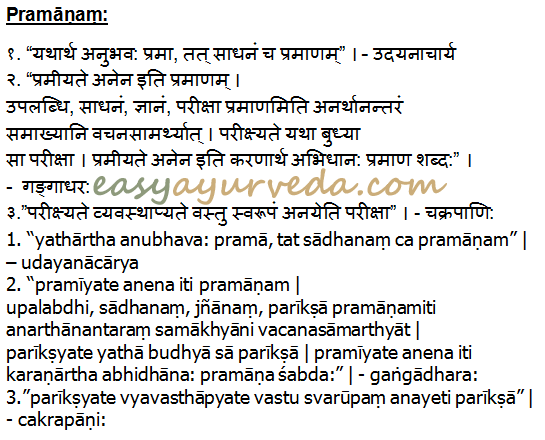Pramana: Definition, Types As Per Sushruta And Charaka
By Prof. Vd. Rangaprasad Bhat
Pramana is the means to gain knowledge. For example, we see an object and understand it as a bird. This is called Pratyaksha Pramana – knowledge gained through sense organs.
The knowledge which provides the real or genuine experience (yathartha anubhava) is : prama. The scale of measurement (sadhana) of that prama is pramana.
Pramama is tool and prama is the sadhyaphala / jnana (i.e., knowledge).
Table of Contents
Different denotions of Pramana
Upalabdhi, sadhana, jnana, parikshya and pramanaym – though seems to be wrong meaning, the interpretations based on eloquent efficacy. The one that which gets examined and analysed before accepting it as a true knowledge is pariksha, prama. And by means of such pareeksha, the measuring of the truth of the knowledge happens. hence is denoted as pramana.

To understand the aihika & paralaukika principles, the knowledge of pramana becomes essential.
Categories of Jnana
Based on the commonality / similar and specificity / dissimilar features, the, Jnana is sub categorised into two.
1. Nirvikalpa
2. Savikalpam
Based on the lone factor of general appearance , the illustrative knowledge (dhyautaka?) thus obtained is termed as nirvikalpa (Definitive knowledge).
Contrast to above, based on the specific traits or characters of that partcicular object, when the differential knowledge gets recognised by the mind it gets termed as Savikalpam.
For example, recognition of vatarakta becomes Nirvikalpa and differential diagnosis of the same based on its presentation, area affected getting daignosed as uttana vatarakta & gambheera vatarakta
the knowledge thus obtained is considered to have been accrued through the savikalpa pramana. Where in the common or provisional diagnosis of vatarakta gets anekadha and gets categorised into more than one category.
Yathartha and Ayathartha Jnana
The pram? is the knowledge gained from the experience of cognition of objects or events as seen and felt in their actual form of manifestation or appearance.
The knowledge is also categorised based on the cognition level as Yathartha & Ayathartha jnana. Out of these two sub types, the prama (real perception) occurs only in the former category, the yathartha jnana. For the pram? is directly proportional to the truth.
Pramana as per Sushruta
Sushrutokta four pramanas:
Agama
Pratyaksha
Anumana
Upamana
Pratyaksha
Pratyaksha is the exact perception of knowledge of the object. The un-perplexed observation and registration of the physical traits of the object over the axis of mind is pratyaksham. Example for pratyakha aviruddha (perceptible knowledge) is manifestation of sneezing upon gazing the sun for a longer time and upon inserting a thread inside the tip of the nasal cavity.
Agama
Agama is related to the vedas (authoritative statement from the learned and elderly persons).
Example for Agama pramana is “ the story of decapitation of the head of daksha by Rudra during brahma yajna, which was surgically reconstructed by Aswini Kumaras, being heard through puranas and other scriptures.
Anumana
– On observing the definitive; characteristic traits and the signs,begetting some fixed and inferred knowledge is termed as anumanam.
Example:- In an impacted foreign body underneath the surface of skin, inferring the presence of the foreign body by applying candana, ghrita and observing for the drying and liquifaction of those dravyas, respectively is indicative of obtaining the knowledge through anumanam.
Upamana
Based on the popular instrument or object, denoting an object which is away from that place having the similiarity or homogenousness of the popular object by means of comparison, the knowledge of upam?na? is achieved.
The reddish swelling of the lesion present over the axilla, groin & joints that which is round in shape resembling the underground tubers of the Pueraria tuberosa (vidarikanda), caused by the tridoshas is known as Vidari kshudra roga (regional lymph node swellings).
Pramana as per Charaka
Carakokta caturvidha pramana: –
1. Aptopadesha
2. Pratyaksha
3. Anumana
4. Yukti
C.S.sU.11/17









